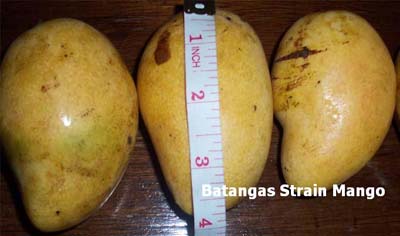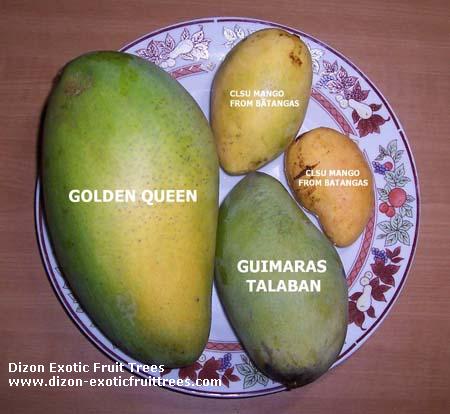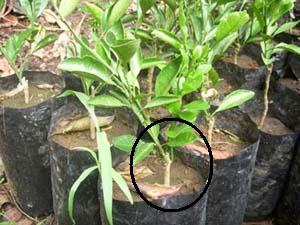|
|
|
Practical Guide to Backyard and Orchard Farming |
|
TIPS IN BUYING PLANTING
MATERIALS |
|
|
|
After
spending millions for the land, fence, rest house and other
structures, the orchard grower would probably think of
buying cheap planting materials because his budget is
already exhausted. |
 |
The
low-priced seedlings will also grow well, especially
if they are the native variety. He will have the
"shock" of his life, when the fruits turn sour
instead of the variety guaranteed by the seller of
the seedlings. His orchard dream farm will then
become a nightmare. This usually happens when an
orchard grower is |
|
Photo shows an INFERIOR
BATANGAS STRAIN Carabao Mango bought from unreliable
nursery with one peso as reference size |
|
|
influenced and
deceived by the sweet sales talk of the sources of cheap but
inferior seedlings who are mostly middlemen. No amount of
publicity will make an inferior variety produce superior
quality fruits |
|
|
|
In the late '80s,
a company engaged in buying
and selling seedlings and made a lot of money. They
paid ads in newspapers claiming that the products
are imported and superior when in fact, they were
only bought from several local nurseries in Southern
Luzon. When the seedlings bought from
the company bore inferior quality fruits, the
company lost customers and eventually closed the
business. |
 |
|
|
|
|
In the early '90s, an ordinary employee who earned a diploma
in Agriculture became an instant millionaire because he was
used as a 'mango
expert' of an
agricultural TV program sponsored by a congressman.
Because of his TV
exposure, he ventured in buying and selling of Carabao mango
seedlings and he fooled his TV audience that he himself
propagated what he was selling. His stocks
sold like hotcakes so he ordered more truckloads of
seedlings from other nurseries. He even recommended high
density planting Carabao mango with a distance of 5 x 5
meters to make more money from the sales of seedlings.
However, the mango planted in a very close distance became
overcrowded before commercial fruiting, thus the owners had
to cut in-between tree to make the distance at 10 x 10
meters. After several years, most of the Carabao seedlings
bought from the pseudo-expert bore inferior quality fruits.
Many of the 'Carabao
mango' seedlings he sold were not actually Carabao mango,
but inferior varieties like Supsupin (Señorita), Pico,
Indian mango, and other manipulated seedlings. When the
seedlings he sold bore inferior quality fruits, no one
trusted him anymore. |
|
|
 |
These incidents only confirm that publicity alone
does not guarantee the quality of planting materials
sold by nurseries. It is very
necessary to survey the nursery and look for the
mother plant where the propagator gets his scion or
bud sticks before buying anything. Know first if the
nursery operator is credible based on his previous
seedlings' transactions. Further, see to it that the
mother plant is healthy and bearing fruits
especially when you will purchase cultivars that are
mostly 70% male when grown from seeds, such as
lychee, rambutan and longan. |
|
|
There are
even nurseries with no mother plant fool customers by
cutting the seedling and grafting the top of the same plant.
The seedlings will then appear as grafted plants and the
nursery operator will pass it off as asexually propagated
seedlings which command a price higher than seedlings which
are not manipulated. If female, the manipulated seedlings
will also bear fruits for a long period, as in the case of
rambutan and lychee, but expect it to be inferior varieties.
There is no outright possibility that it will produce
commercial quality fruits, not to mention that it will also
grow slowly.
A former Department
of Agriculture secretary was victimized by this wrongdoing
of some crooked nursery operators. The former secretary
bought grafted Carabao mango for his company's plantation.
Six years after the date of planting, he sprayed flower
inducer (KNO3) but the mango only produced flushes or
shoots. On its 7th year, he sprayed the chemical again but,
likewise, only flushes came out and no flowers. On the 8th
year, few trees finally reacted positively to the chemical
but it was only on the 9th year where many mango trees bore
flowers and yielded fruits. He also observed that the
Carabao mango trees vary in quantity and inferior quality
fruits produced.
This would be the case when a Carabao mango seedling is
cut and the same top portion of it is used as the scion. |
|
To be sure of the
cultivars:
study first the growth habit, shape and color of the leaves,
see the mother plant and buy only from accredited nursery
operator. |
|
|
Remote
supervision may result to low quality or adulterated
production of seedlings. The laborers, who are only after
their income, often do malpractices. The propagator may even
graft the same part or scion as what happened to grafted
carabao mango seedlings planted by a former Department of
Agriculture secretary. The plant bore fruits only after 8 -
10 years from planting.
In our propagation, we see to it that all varieties are
propagated one at a time to avoid unintentional mixing of
varieties. Maximum supervision is being observed in helping
backyard and orchard growers produce high quality fruits
because this is our lifetime vision and livelihood.
|
|
|
|
|
 |
In buying
citrus varieties like pummelo, oranges and calamansi, see to
it that the point of union otherwise known as the budding or
grafting point, is more than six inches above the base of
the rootstock. Low budding point is very susceptible to foot
rot disease, the number one killer of citrus in the country.
Further, the rootstock must be compatible with the
scion. Meaning, a pummelo must be grafted only with pummelo
seedlings and not the calamandarin rootstock which is two to
three times smaller than the first. In case calamandarin is
substituted, make sure that the rootstock is double to
overcome incompatibility. |
|
Photo
shows low budded citrus which is very susceptible to
foot rot disease. |
|
|
|

